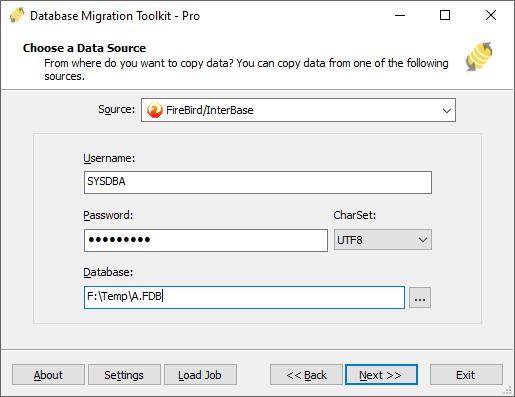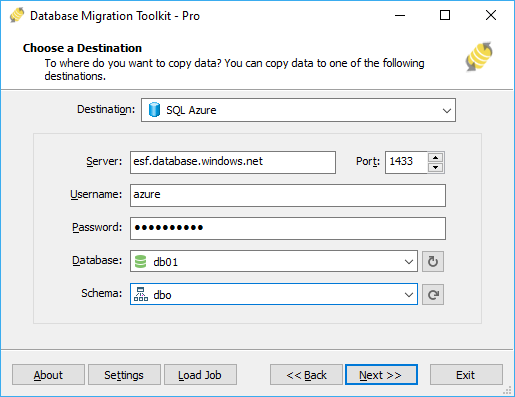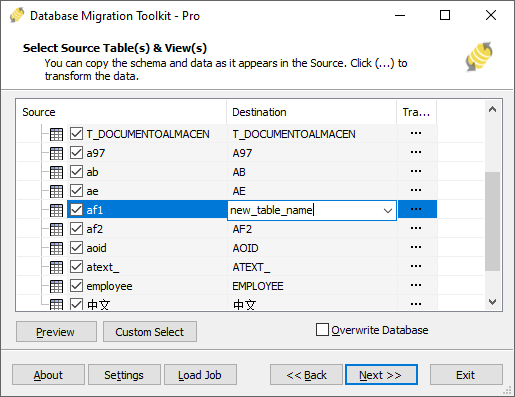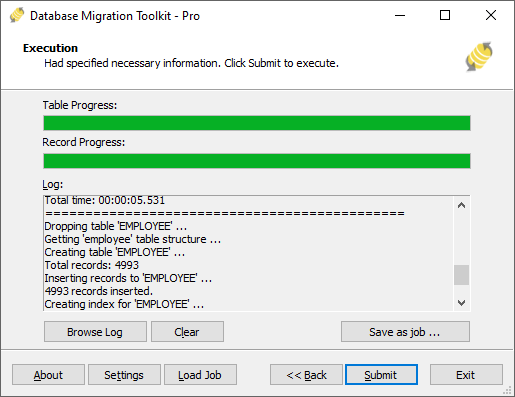Migrating data from Firebird to SQL Azure
This guide walks you through migrating data from Firebird to SQL Azure in a few simple steps using ESF Database Migration Toolkit. Simplify complex migration tasks and save valuable time with our streamlined approach.
Firebird vs. SQL Azure:
- FireBird is an open-source relational database management system (RDBMS) that offers robust features, high performance, and scalability. It provides cross-platform support, running on Windows, Linux, macOS, and various Unix platforms. With its SQL compliance, ACID transactions, and multi-generational architecture, Firebird is well-suited for both small-scale applications and enterprise-level deployments. Additionally, its lightweight footprint and minimal administration requirements make it a popular choice for embedded database solutions.
- Microsoft SQL Azure, also known as Azure SQL Database, is a fully managed relational database service provided by Microsoft. It offers scalable and high-performance SQL database capabilities in the cloud, with built-in high availability, automated backups, and robust security features. Designed to handle both small and large-scale applications, Azure SQL Database simplifies database management tasks, allowing developers to focus on building applications without worrying about underlying infrastructure. It supports various deployment options, including single databases, elastic pools, and managed instances, catering to diverse business needs.
Prerequisite:
Software Required:
DMToolkit_x64.zip
(63.6 MiB)64-bit Windows application for ESF Database Migration Toolkit 12.2.08 (2025-07-11).
(md5: e93a0ef57622bfd8ee77d6aa6e38c13b)DMToolkit_win32.zip
(58.8 MiB)32-bit Windows application for ESF Database Migration Toolkit 12.2.08 (2025-07-11).
(md5: bd34cb7f73c88c6d0c7a44069ad756d6)System Supported:
- Windows 7 or higher.
- Firebird 1.5 or higher.
- SQL Azure.
Step by Step Wizard:
-
Configure Firebird/InterBase Connection
- In the Choose a Data Source dialog:
- Select Firebird/InterBase from available options
- Provide authentication credentials:
- Username: SYSDBA (default)
- Password: masterkey (default)
- Select the database character set from dropdown
- Specify database location:
- Click the [...] button (Browse)
- Select your Firebird (.fdb) or InterBase (.gdb) file
- For network connections:
- Enter server address in format:
[server_name][/port][/path_to_file] - Examples:
localhost/3050:/var/db/test.fdbdbserver.example.com:/data/prod.gdb
- Enter server address in format:

Fig. 1: Configuring Firebird/InterBase data source - In the Choose a Data Source dialog:
-
Configure SQL Azure Data Destination
- Prerequisite:
- Enable access in Azure server's "Firewalls and virtual networks" page
- Add your client IP to the firewall rules
- In the "Choose a Destination" dialog:
- Select "SQL Azure"
- Enter server details:
- Server name: e.g.,
esf.database.windows.net - Port:
1433(default)
- Server name: e.g.,
- Provide authentication credentials:
- Username and password
- Database selection:
- Click Refresh Database to load databases
- Select target database
- Schema selection:
- Click Refresh Schema to load schemas
- Choose existing schema (
dboschema is default)

Fig. 2: SQL Azure data destination configuration - Prerequisite:
-
In "Select Source Table(s) & View(s)" Dialog
-
Select migration objects: Choose tables or views to include in the migration.

Fig. 3: Select tables and views -
Modify table structure: Click the ellipsis (...) button to access table options and schema adjustments.

Fig. 4: Do transform -
Configure field mapping: In the Field Mapping options:
- Customize destination fields (name, data type, default value, comments)
- Select data transfer method:
- Overwrite Table (replace existing data)
- Empty Data (truncate before insert)
- Append Data (add to existing data)
- Skip Table (exclude from transfer)
- Apply data filters before transfer
-
Select migration objects: Choose tables or views to include in the migration.
-
Execution Dialog
-
Start migration: Click "Submit" to initiate automated data transfer from Firebird to SQL Azure.

Fig. 5: Execute migration - Monitor progress: Click "Browse Log" for real-time migration tracking, including issue resolution details.
-
Save configuration: Click "Save as job" to store settings for:
- Quick reloads of migration jobs
- Command-line execution (use:
dmtc.exe --helpfor parameter options)
-
Start migration: Click "Submit" to initiate automated data transfer from Firebird to SQL Azure.
-
Finished!
After migration completes, the toolkit generates a comprehensive report for verifying migration accuracy. You can monitor progress as the automated process runs efficiently. For any questions or feedback, contact us – our team is ready to assist.